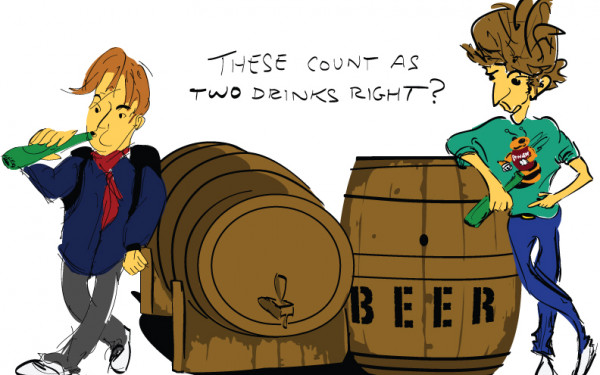Blame It on the A-A-A-Alcohol
Looking at the Gendered Dimensions of Alcohol Advertising
Walking by the boisterous floats and crowded streets of downtown Montreal during the St. Patrick’s Day celebrations, it was the young, incapacitated men and women running amok that caught my attention.
They were dressed in festive gear from head to toe, their green-coloured glasses perched on contorted, red faces. Countless young men and women were stumbling in the crowds; a few eventually lost consciousness. Many had been surreptitiously trying to keep up with the heaviest drinkers among them.
“As a culture, we’re living in major denial. It’s time for an adult conversation. It’s time for a dialogue to begin,” said Ann Dowsett Johnston, winner of five National Magazine Awards and former vice-principal of McGill University. A panelist on the National Roundtable on Girls, Women and Alcohol, she is on a mission to disseminate information and the truths behind the advertising industry’s powerful role in the relationship some women have with alcohol.
Johnston is the author of the national bestseller Drink: The Intimate Relationship Between Women and Alcohol and believes that this 360-degree marketing, embedded in social media like Facebook, Twitter and YouTube as well as on television and in the movies, contributes to people drinking at a young age.
The numbers should be a serious wake up call. Over 23,000 women in the United States die from excess drinking every year, according to Johnston, but these numbers are not being broadcasted to women.
“The alcohol business, like the tobacco business beforehand, has taken aim at the female market, and scored,” Johnston said in Drink. “Risky drinking has become normalized, and not all young women will mature out of it. In fact, many—like myself—may mature into it.”
The CRTC hasn’t changed the advertising laws for alcohol since 1996 and now, almost 20 years later, the Internet has become a marketing playground that has helped alcohol advertisers flourish.
Dan Delmar, co-founder and managing partner of the Montreal public relations agency Provocateur Communications, thinks that lifestyle branding and pull marketing play a crucial role in the alcohol advertising industry. “Much of the beer people drink has tasted the same for centuries,” he said. “As a consequence, marketers need to get creative and overcompensate a bit.
“Beer companies have managed quite brilliantly to make their brands synonymous with things like hockey or football,” Delmar continued. “That’s more than a brand, it’s a part of a dude’s routine.”
Johnston and Delmar have both conveyed that the alcohol industry has become almost as powerful as the tobacco industry was in the ‘60s.
“The alcohol industry has at times taken the lead of big tobacco,” said Delmar. According to Johnston, the alcohol industry has become much like the tobacco industry in the sense that it has started to aggressively pursue young, female market segments.
In Johnston’s book Drink, Jean Kilbourne—the author behind Can’t Buy My Love: How Advertising Changes the Way We Think and Feel—discusses how oblivious we seem to be to the direct impact that advertising has on us. “Ads are so trivial and silly that people feel above them,” Kilbourne told Johnston. “And for that reason, they don’t pay conscious attention. The advertisers love it: our radar is not on. We’re not on guard; it gets into our [non-conscious awareness] and affects us very deeply.”
Although it appears that alcohol advertisers have kept the same form over decades, the simplistic nature of the messages keeps the ads memorable.
“Drink an American beer, babes appear out of thin air…just that simple,” said Delmar. “Modern men are becoming more skeptical about some of these tired clichés in advertising. On the other end of the spectrum, there are highly successful brands geared toward female drinkers; Skinnygirl comes to mind. That brand is pretty overt about its target demographic,” Delmar said.
Johnston hopes that young women will eventually be propelled to talk more about their consumption habits. She believes that a public health dialogue about risky drinking needs to be opened to re-focus the conversation on the actual risks attached to heavy drinking. Not only are some “young women experimenting with the strongest beverage, but they’re more vulnerable because of the way alcohol metabolizes in the female body,” Johnston said. “There’s a real initiative on a lot of campuses focusing on what safe drinking looks like.
Johnston’s panel will arrive in Montreal on November 17. “Rather than having it talked down, it’s much more effective if the students try to talk amongst each other,” she said. “We’ve done such a good job at talking about what depression looks like and de-stigmatizing mental health issues but we’ve got long way to go from de-stigmatizing alcohol.”

_900_643_90.jpg)
_600_832_s.png)

__600_375_90_s_c1.jpg)


_600_375_90_s_c1.jpg)